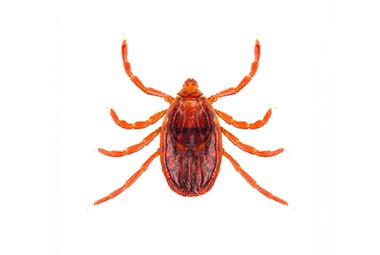
The brown dog tick (also known as the kennel tick) is found through most of the United States. They seldom attack animals other than dogs and are most likely found where dogs are kept in or around the house. The brown dog tick is not known to transmit diseases to humans but may transmit disease among dogs. We care about you and your furry friends. Give us a call today for pest control services!
| Pest Identification | |
|---|---|
| Recognition | Size: 1/4 in. Color: Reddish brown Body Structure: Flat body with eight legs Characteristics: Female adults when fully gorged with host blood may produce as many as 500,000 eggs, laying them in secluded cracks and crevices. The female coats the eggs in a secretion to keep them from drying out, and then dies after completing this process, which may take as long as 15 days. When the eggs hatch, the larva go in search of food, gorging themselves on a host until molting, upon which they enter the nymph stage. Here again, nymphs will seek a new host, gorging themselves on blood until molting and emerging as an adult. In indoor/enclosed environments, young ticks will gorge on the same animal instead of finding new hosts. Furthermore, the brown dog tick is unique in that it can complete the entire life cycle indoors. Commonly Active: Spring / Summer / Fall |
| Habits | In the wild, brown dog ticks can be found residing on tall grasses or vegetation, where they wait to attach themselves to a passing mammalian host. While they will feed on animals such as rabbits or deer, they prefer dogs, hence the name. Generally, adult brown dog ticks will attach themselves just behind a pet’s ears or between its toes. Initially infestation may go undetected. It is often during the larval stage, when the undeveloped young disperse in search of food, that one will see thousands of offspring, crawling in and around a pet’s bedding area. Like its counterparts, the brown dog tick is also a vector pest, capable of transmitting disease, including Rocky Mountain Spotted Fever. |
| Prevention | Checking pets and their sleeping areas for ticks is a good preventative measure. Likewise, if spending time outdoors, spraying your clothes and shoes with a pest repellent containing DEET will help protect you from the parasites. Although brown dog ticks more commonly feed on pets rather than humans, if you find a tick on your body, remove it by using tweezers, pulling it from your body as close to its mouthparts as possible. Should you experience any fever, nausea, profuse sweating, or adverse reaction to the bite, seek medical attention immediately. If you suspect an infestation in your home, refrain from do-it-yourself treatments. Brown dog ticks multiply quickly and are difficult to eradicate. Contact a pest control professional to inspect your home and implement a proper course of treatment. Find out more about tick prevention and extermination options. |

